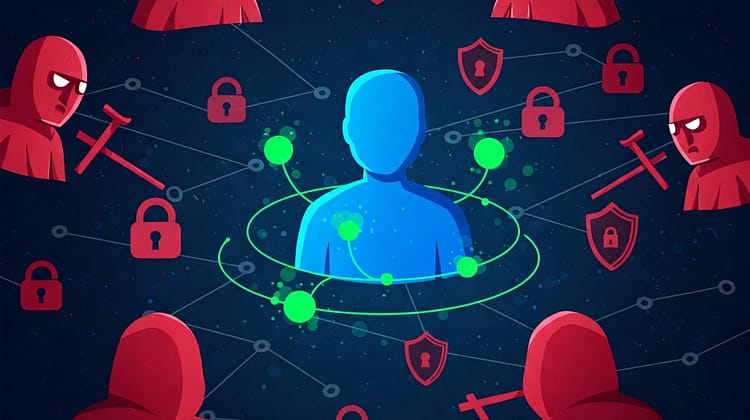
The Escalating Crisis of Identity Theft and Data Breaches
In 2025, the digital revolution has brought unparalleled convenience—and unprecedented risks. Identity theft and data breaches now rank among the top global threats, with cybercriminals leveraging artificial intelligence (AI), quantum computing, and sophisticated social engineering to exploit vulnerabilities. In the first half of 2024 alone, over 1 billion individuals fell victim to data breaches, a 490% surge from the previous year 513. This article delves into the latest trends, high-profile breaches, and cutting-edge strategies to safeguard your digital identity in an increasingly perilous world.
Understanding Identity Theft and Data Breaches
What Are Identity Theft and Data Breaches?
- Identity Theft: Unauthorized use of personal information (e.g., Social Security numbers, bank details) for financial fraud, impersonation, or criminal activity.
- Data Breaches: Incidents where sensitive data is accessed, stolen, or exposed by malicious actors. Common targets include healthcare records, financial data, and corporate intellectual property.
The Connection Between Data Breaches and Identity Theft
Data breaches often serve as the catalyst for identity theft. For example, the Change Healthcare breach in 2024 exposed 100 million patients’ records, enabling criminals to commit insurance fraud and medical identity theft 5. Similarly, the Santander Bank breach compromised 30 million customer accounts, leading to widespread financial fraud.
2025 Statistics and Trends
Alarming Data Breach Statistics
- Global Financial Losses: The average cost of a data breach reached **4.45million∗∗in2023,withremoteworkadding4.45million∗∗in2023,withremoteworkadding137,000 per incident.
- Industries Most Affected:
- Healthcare: Targeted for sensitive patient data (e.g., 13.4 million records exposed in the Kaiser Foundation breach).
- Finance: Banks like Evolve Bank suffered breaches impacting 7.6 million customers.
- Government/Military: Attacks on critical infrastructure and national security data.
Emerging Threats in 2025
- AI-Driven Attacks: Cybercriminals use AI to automate phishing campaigns, crack passwords, and mimic user behavior.
- Quantum Computing Risks: Quantum computers threaten to break traditional encryption (e.g., RSA, TLS), risking global data exposure.
- Non-Human Identity (NHI) Exploits: Machine identities (e.g., API keys, IoT devices) now outnumber human identities 45:1, creating new attack surfaces.
- Third-Party Vulnerabilities: Supply chain attacks, like the MOVEit breach, highlight risks in vendor ecosystems.
How to Prevent Identity Theft and Data Breaches
For Individuals
- Monitor Credit Reports: Request free annual reports from Equifax, Experian, and TransUnion to spot unauthorized activity.
- Enable Multi-Factor Authentication (MFA): Use biometrics or authentication apps instead of SMS codes.
- Secure Offline Data: Shred sensitive documents and avoid sharing personal details over unsecured channels.
- Adopt Passwordless Authentication: Transition to FIDO2-compliant passkeys for banking and social media accounts.
For Organizations
- Implement Zero Trust Architecture: Authenticate every access request, regardless of origin.
- Encrypt Data and Segment Networks: Use AES-256 encryption and isolate critical systems to limit breach impacts.
- Conduct Regular Security Audits: Partner with third-party experts to identify vulnerabilities.
- Train Employees: 52% of breaches stem from human error; use simulations to combat phishing.
- Prepare for Post-Quantum Cryptography (PQC): Inventory encryption methods and adopt quantum-resistant algorithms.
Legal and Regulatory Developments
Global Privacy Laws
- EU’s eIDAS 2.0: Mandates decentralized digital identity wallets to reduce fraud.
- U.S. State Laws: 26 states now have privacy laws, including Texas (TDPSA) and Florida (FDBR), with more taking effect in 2025.
- AI Regulations: The EU AI Act and Colorado’s AI Act aim to mitigate risks like surveillance and data distortion.
Compliance Challenges
Organizations must navigate fragmented regulations while addressing AI’s ethical dilemmas, such as biometric data misuse and algorithmic bias.
The Future of Identity Security
Passwordless Authentication Dominance
Tech giants like Google and Apple are driving FIDO2 adoption, replacing passwords with biometrics and hardware tokens.
Decentralized Identity Systems
Blockchain-based solutions empower users to control their digital identities, reducing reliance on centralized databases.
AI-Powered Defense Mechanisms
- Behavioral Biometrics: Analyze typing patterns and mouse movements for continuous authentication
- .
- Predictive Threat Detection: AI identifies anomalies in real time, slashing response times.
Quantum-Safe Encryption
NIST’s upcoming quantum standards will guide enterprises in transitioning to lattice-based cryptography .
Staying Ahead in 2025 and Beyond
The battle against identity theft and data breaches demands vigilance, innovation, and collaboration. By adopting zero trust frameworks, leveraging AI-driven tools, and complying with evolving regulations, individuals and organizations can mitigate risks in an increasingly interconnected world. As Eva Velasquez, CEO of the Identity Theft Resource Center, warns: “Respecting data privacy isn’t optional—it’s the cornerstone of trust in the digital age” .
Call to Action: Subscribe to cybersecurity newsletters, use tools like Truehost Vault for backups, and explore decentralized identity solutions like MySudo to safeguard your digital future.
FAQ
- What’s the biggest data breach in 2024?
The Change Healthcare breach impacted 100 million individuals . - How can I protect my business from AI-driven attacks?
Deploy MFA, encrypt data, and conduct AI-specific risk assessments . - Are passwords obsolete?
Yes—passkeys and biometrics are replacing them to combat credential theft.
For further insights, explore RSA’s Top Trends in Identity 2025 and the ITRC’s 2024 Annual Data Breach Report .

Leave a Reply